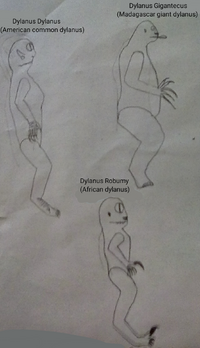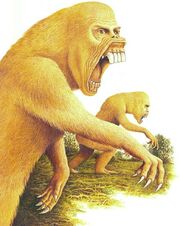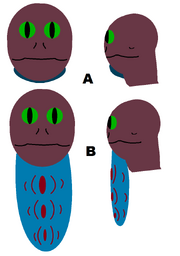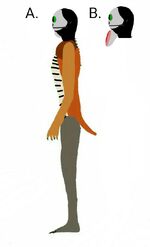
The outdated sketch showing the three example species of all todays dylanus.
All todays dylanuses are former fictional outdated-looking dylanus species that now exist in real life North America (along with real dylanus species).
All Todays description on dylanuses[]
The fossils of these mostly-bipedal creatures were found all over the world, except Antarctica. They came in many different shapes and sizes, living in almost every kind of climates and habitats where they thrived in. We don't know what dylanuses really looked like exactly, but scientists believed that they had large gecko-like eyes, wide mouths that could have opened very wide like a Thylacine (another extinct Holocene animal), noses that could have been flat, sharp claws (with few species like the Dylanus Robumy especially very large and sickle-like to hunt and kill larger animals), sharp teeth for slicing flesh, few flat teeth for grinding some plant matter, and probably had scaly skin in some species (like the Dylanus Dylanus) and/or fur in some species (like the Dylanus Edwienus).

A possible restoration of a Dylanus Edwienus (with a possible subspecies, Dylanus Edwienus Floridanus, in the background) as a peaceful herbivore that feeds on leaves and fruits, they were restored with fur as recent evidence confirmed.
There are also some evidence that some species had ears, with some having probably either short ears or even elf-like points at the end, possibly for acute sense of hearing. Their tailbones are likely incomplete, some paleontologists suggested that they had either short or long tails, if long, could have been used for balancing when walking/running, if short, probably lost their use or had developed plumage on their tails for display like modern birds have today. The largest of the dylanuses were the Dylanus Indicus Megadontus, which were most likely quadrupedal due to their gigantic sizes and heavy weight, so they probably had very elephant-like feet and hands. We do not know much about their behavior, but some species like the dylanus robumy probably hunted in packs to hunt larger extinct Holocene animals like rhinos, hippos, buffaloes, and some other big prey items and used their claws to rip flesh off of their helpless victims (in a similar fashion to dromaeosaurs [raptor dinosaurs of the mesozoic]). Dylanus dylanus was probably

Another possible restoration of a Dylanus Dylanus as a colorful animal. Just like some of today's birds, males probably had a skin flap on their necks to attract mates and/or even to scare off predators. A, male with his skin flap retracted and not brightly colored. B, male with his skin flap extended out and showing bright colors of blue and red.
semi-aquatic, using their webbed feet and hands with sharp claws to paddle through water and hunt fish and crustaceans in lakes and rivers across what is now North America, but could have also fed on fruits and leaves, as their molars suggests, but is suggested that they didn't have webbed feet/hands, so they probably didn't spend a lot of time in water and instead had only sharp claws and used them mainly for hunting much bigger prey such as rhinoceroses. Some larger fossils suggested that Dylanus Dylanus could have grown to about the size of Dylanus Gigantecus, making them powerful predators, but some scientists suggested that these so-called giant Dylanus Dylanus fossils are more likely a completely different species and not from Dylanus Dyalnus. Since the closest living relatives of dylanusids and other mammals are birds and crocodilians, the sounds of many dylanusids were recreated in recent times using the sounds of a Eurasian bintern, Steller's sea eagle, and a large-billed crow, which all survived Holocene extinct and still live today, while some other dylanusid sounds such as Dylanus Dylanus was also recreated by mixing usual recreated dylanusid sounds with three other modern animal sounds such as a hawk screech, an alligator bellow, and a cobra hiss, based on recent studies, so the Dylanus Dylanus may have had sounded like the Mesozoic raptors and Troodont dinosaurs, but more recent studies showed that they may have sounded differently and recent scientists recreated dylanus by mixing sounds of a capuchinbird call and a Eurasian bittern booming sound. Dylanus Gigantecus could have been herbivorous, so it may have browsed on treetops to feed on leaves and fruit using their alien-looking hands ending with large scythe-like claws to pull down branches (much like the mesozoic therizinosaurs) and licked the fruits and leaves off the branches with their long sticky tongues. The mating of all dylanus species is probably like that of birds, with males fighting

Another possible restoration of a Dylanus Dylanus with a coloration based on white-faced whistling ducks, which are still alive today and survived the Holocene extinction. It is possible that the dylanuses were related to whistling ducks of today and, therefore, dylanuses were likely bizarre and primitive birds. A. The full body of a Dylanus Dylanus B. A hypothetical male Dylanus Dylanus with its inflated throat, swelling with blood vessels to make it red in color to attract mates and/or scare off predators, but it may not have had the ability to inflat its throat at all unlike this restoration.
other males to win a right to mate, and the pair would have mated in a similar fashion to other large megafauna like cattle, sheep, goats, pigs, tapirs, antelopes, deer, and other Holocene megafauna. Like today's birds, dylanuses probably built nest for the females, but unlike birds, they probably gave birth to live young, instead of eggs, in nests, but they could have laid hard shelled eggs like today's birds, no one knows for sure currently. They were most likely very social, however, they sometimes could have live alone in solitary lives as not all animals alive today could have been social. It is possible that dylanuses could have been cold-blooded, so they could have grown slowly like most reptiles, amphibians, and fish species, and they could have also aged very slowly, possibly living for about 200-300 years.
Introduction to real life North America[]
Since real life humans had introduced all known species of all todays dylanuses (including many kinds of restorations of each species, such as alienoid-looking Dylanus Dylanus with white-faced whistling duck colorations and all others) to real life North America, these dylanuses now coexist alongside real dylanus species, including a very human-like American common dylanus and among others (both native and nonnative). Unlike their ancestors, however, they are no longer aggressive to any sapient species/beings, as any aggressive animals aren't tolerated. They can now also thrive well in cities across the continent to ensure their further survival alongside real dylanus species.
| All Todays Dylanus |
|---|
|
